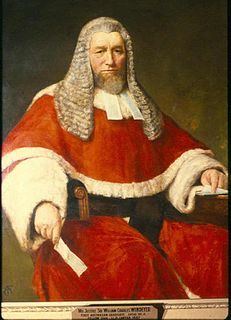| Sir Matthew Henry Stephen KC | |
|---|---|
| Member of the New South Wales Parliament for Mudgee | |
| In office 16 December 1869 –12 December 1871 | |
| Preceded by | Samuel Terry |
| Succeeded by | Henry Parkes |
| Judge of the Supreme Court of New South Wales | |
| In office 19 May 1887 –25 February 1904 | |
| Personal details | |
| Born | 5 December 1828 Hobart, Van Diemen's Land |
| Died | 1 April 1920 (aged 91) Bellevue Hill NSW |
| Spouse(s) | Caroline Sibella née Shadforth Florence Sophie, née Huthwaite |
| Parents | Sir Alfred Stephen, Mary Anne, née Pasmore |
| Occupation | Barrister, politician, judge |
Sir (Matthew) Henry Stephen (5 December 1828 – 1 April 1920), was a politician and Puisne Judge in New South Wales. [1]

New South Wales is a state on the east coast of Australia. It borders Queensland to the north, Victoria to the south, and South Australia to the west. Its coast borders the Tasman Sea to the east. The Australian Capital Territory is an enclave within the state. New South Wales' state capital is Sydney, which is also Australia's most populous city. In September 2018, the population of New South Wales was over 8 million, making it Australia's most populous state. Just under two-thirds of the state's population, 5.1 million, live in the Greater Sydney area. Inhabitants of New South Wales are referred to as New South Welshmen.
The Stephen family is a prominent legal dynasty in Australia. [2] Stephen was the eldest son of the Hon. Sir Alfred Stephen KCMG CB (1802–1894), who would later become Chief Justice of NSW and Lieutenant-Governor of NSW, [3] and was born at Hobart, Van Diemen's Land (later named Tasmania). [4] He was called to the New South Wales Bar in 1850, and became Q.C. He was a member of the New South Wales Legislative Assembly for Mudgee from December 1869 to December 1871, [1] and was a Puisne Judge of the Supreme Court of New South Wales from 1887. He married on 30 September 1854, Caroline Sibella, daughter of Henry Tudor Shadforth, formerly of the 57th Regiment, and Usher of the Black Rod, New South Wales. Sir Henry was Chancellor of the Church of England diocese of Sydney. [4]
The Stephen family is a prominent legal dynasty in Australia that has produced a number of judges and jurists. Members include:

Sir Alfred Stephen was an Australian judge and Chief Justice of New South Wales.
The Chief Justice of New South Wales is the senior judge of the Supreme Court of New South Wales and the highest-ranking judicial officer in the Australian state of New South Wales. The Chief Justice is both the judicial head of the Supreme Court as well as the administrative head. He or she is responsible for arranging the business of the court and establishing its rules and procedures.
Stephen was senior vice-president of the New South Wales Cricket Association and from 1895, was a fellow of the Royal Colonial Institute. [5] Stephen died at Bellevue Hill, Sydney, New South Wales, Australia on 1 April 1920, survived by his second wife (Florence Sophie, née Huthwaite) and by Caroline, his only daughter from his first marriage. [5]











